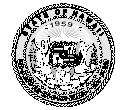

HAWAII
State of Hawaii
ORIGIN OF STATE NAME: Unknown. The name may stem from Hawaii Loa, traditional discoverer of the islands, or from Hawaiki, the traditional Polynesian homeland. NICKNAME: The Aloha State. CAPITAL: Honolulu. ENTERED UNION: 21 August 1959 (50th) . SONG: "Hawaii Ponoi." MOTTO: Ua mau ke ea o ka aina i ka pono (The life of the land is perpetuated in righteousness). COAT OF ARMS: The heraldic shield of the Hawaiian kingdom is flanked by the figures of Kamehameha I, who united the islands, and Liberty, holding the Hawaiian flag. Below the shield is a phoenix surrounded by taro leaves, banana foliage, and sprays of maidenhair fern. FLAG: Eight horizontal stripes, alternately white, red, and blue, represent the major islands, with the British Union Jack (reflecting the years that the islands were under British protection) in the upper left-hand corner. OFFICIAL SEAL: Same as coat of arms, with the words "State of Hawaii 1959" above and the state motto below. BIRD: Nene (Hawaiian goose). FLOWER: Pua aloalo (yellow hibiscus). TREE: Kukue tree (candlenut). ISLAND EMBLEMS: Each of the eight major islands has its own color and emblem. HAWAII: red; lehua (ohia blossom). KALHOOLAWE: gray; hinahina (beach heliotrope). KAUAI: purple; mokihana (fruit capsule of the Pelea anisata). LANAI: orange; kaunaoa (Cuscuta sandwichiana). MAUI: pink; lokelani (pink cottage rose). MOLOKAI: green; kukui (candlenut) blossom. NIIHAU: white; white pupu shell. OAHU: yellow; ilima (Sida fallax). LEGAL HOLIDAYS: New Year's Day, 1 January; Birthday of Martin Luther King, Jr., 3rd Monday in January; Presidents' Day, 3rd Monday in February; Kuhio Day, 26 March; Good Friday, March or April; Memorial Day, last Monday in May; Kamehameha Day, 11 June; Independence Day, 4 July; Admission Day, 3rd Friday in August; Labor Day, 1st Monday in September; Discoverers Day, 2nd Monday in October; Election Day, 1st Tuesday after 1st Monday in November; Veterans Day, 11 November; Thanksgiving Day, 4th Thursday in November; Christmas Day, 25 December. TIME: 2 AM Hawaii-Aleutian Standard Time = noon GMT.
50 BIBLIOGRAPHY
Coffman, Tom. Nation Within: the Story of America's Annexation of the Nation of Hawaii. Kaneohe, Hawaii: Tom Coffman/EPICenter, 1998.
Eyre, David L. By Wind, by Wave: An Introduction to Hawaii's Natural History. Honolulu: Bess Press, 2000.
Fuchs, Lawrence H. Hawaii Pono: A Social History. San Diego: Harcourt Brace Jovanovich, 1984.
Haas, Michael, ed. Multicultural Hawaii: the Fabric of a Multiethnic Society. New York: Garland Pub., 1998.
Hawaii, State of. Department of Planning and Economic Development. The State of Hawaii Data Book 1984—A Statistical Abstract. Honolulu, 1985.
Kuykendall, Ralph S., and A. Grove Day. Hawaii: A History—From Polynesian Kingdom to American State. Rev. ed. Englewood Cliffs, N.J.: Prentice-Hall, 1961.
Moore, Susanna. I Myself Have Seen It: The Myth of Hawaii. Washington, D.C.: National Geographic, 2003.
Mykkänen, Juri. Inventing Politics: A New Political Anthropology of the Hawaiian Kingdom. Honolulu: University of Hawaii Press, 2003.
Pratt, Richard C., and Zachary A. Smith, eds. Politics and Public Policy in Hawaii . Albany: State University of New York Press, 1992.
Spickard, Paul, Joanne L. Rondilla, and Debbie Hippolite Wright, eds. Pacific Diaspora: Island Peoples in the United States and Across the Pacific. Honolulu: University of Hawaii Press, 2002.
Trask, Haunani-Kay. From A Native Daughter: Colonialism and Sovereignty in Hawaii. Monroe, Me.: Common Courage, 1993.
Wooden, Wayne S. Return to Paradise: Continuity and Change in Hawaii. Lanham, Md.: University Press of America, 1995.